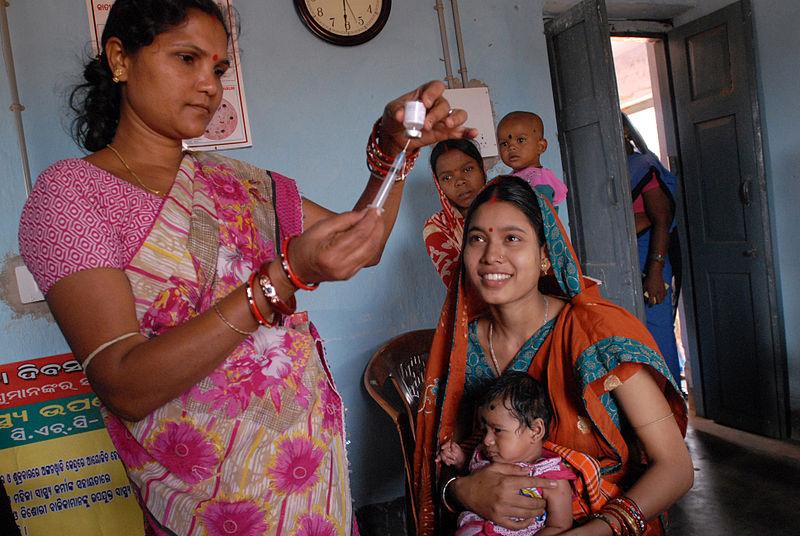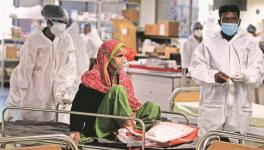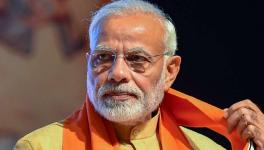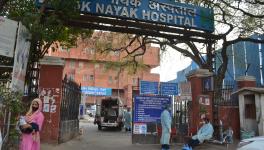Why India’s Healthcare System is Among the Worst in the World

Community health worker participating in a vaccination drive in Odisha
Eminent scholar D.D. Kosambi uses a telling example to illustrate the crisis of Indian feudalism: at the third Battle of Panipat in 1761, the troops on one side had not had enough to eat, while the troops on the other side just managed to assuage hunger by looting villages in the neighbourhood; neither side, in short, had arranged provisions for its troops.
Likewise, the crisis of Indian capitalism is tellingly illustrated by a simple fact: in the midst of this dreadful pandemic, the medical staff in several hospitals in the nation’s capital has not even been paid its regular salary for some time.
But this incident illustrates not just the crisis but also the general nature of Indian capitalism. To see this, let us go back a little in time.
Even before the pandemic, and even before the economic crisis hit India with virulence, the country had a healthcare system that was undoubtedly among the worst in the world; and this was so notwithstanding the hullabaloo about India being an “emerging economic superpower”.
One obvious index of this is the percentage of gross domestic product or GDP devoted to health expenditure. Firm and consistent cross-country data on this are elusive; but the World Bank provides some figures. According to it, India’s total health expenditure, taking both what the government spends and what people spend out of their pockets, as a percentage of GDP, was a mere 3.53% in 2017.
Sub-Saharan Africa
This was lower than the figure for Sub-Saharan Africa for the same year (5.18%). Sub-Saharan Africa includes a “prosperous” country like South Africa; but India’s expenditure percentage was even lower than Sub-Saharan Africa, excluding South Africa.
The World Bank divides countries into various groups, such as High Income, Middle Income and Low Income, and sub-groups such as Low Middle Income, High Middle Income, and so on.
India’s total health expenditure as a percentage of GDP was lower than that of every single such group or sub-group. It was lower than the figure for High Income countries (12.53%), Low and Middle Income countries (5.39%), Low Income countries (5.24%), Middle Income countries (5.39%), Lower Middle Income countries (3.86%) and Upper Middle Income countries (5.84%).
True, international statistics gathered from national data of varying quality, are always somewhat problematic; but there can be little doubt about the validity of the conclusion that the total health expenditure as a percentage of GDP in India is among the lowest of all the countries in the world. It is about the same as for South Asia as a whole (3.46%); but this is because of its own weight in South Asia and also because both Bangladesh and Pakistan are below it.
In the case of Bangladesh, however, we must remember that drug prices there are kept low by official policy, so that a lower figure for health expenditure relative to GDP does not necessarily mean a worse healthcare scenario compared with India.
The US is ill-served in the matter of healthcare because it relies on the health insurance route where private profiteering both by hospitals and insurance companies.
Significantly, the figure for total health expenditure as a percentage of GDP for Cuba (11.74%) was among the highest in the world, and exceeded those of the United Kingdom (9.63%), Germany (11.25%) and France (11.31%).
Among the advanced capitalist countries, it was only the US which had a distinctly higher percentage (17.06%) than Cuba; but as is well-known, despite high health expenditure, the US is ill-served in the matter of healthcare because it relies on the health insurance route where private profiteering both by hospitals and insurance companies is rampant. This is unlike the European countries and Cuba which rely on public provisioning of healthcare.
Though we have used total health expenditure as indicative of the state of healthcare, it is in fact a somewhat misleading index. One reason for this is what we have just mentioned, namely, that the total health expenditure, which includes expenditure incurred on private medical facilities, tends to get inflated by profiteering, so that a higher level of health expenditure may come about through higher profits being extracted.
Privatisation
The second reason is that a higher level of total health expenditure may come about through people being forced to spend even as they are selling off their assets, and hence sinking deeper into poverty. A higher level of total health expenditure, therefore, is not always a good thing, for it may be sustained by a process of immiserisation.
This has actually been happening in India. A major reason for increased peasant indebtedness, which underlies the upsurge in peasant suicides, is the sharp increase in healthcare costs for the people. This has occurred because of the greater privatisation of healthcare during the neo-liberal regime.
For all these reasons, public expenditure on healthcare as a percentage of GDP is a better index of the health welfare of a people than total health expenditure as a percentage of GDP. And on this criterion India’s performance is even more abysmal.
Public health expenditure as a percentage of GDP in India is just over 1%, which is again among the lowest in the world. In 2017-18, for instance, it was 1.17%, which was much lower than the figure for even the “lower income countries” (for whom as a group it was 1.57%). For the European Union as a whole, it was about 7%: the European countries, as noted above, rely predominantly on publicly funded healthcare which constitutes the crux of the welfare state.
India’s public health expenditure as a percentage of GDP is even lower than that of our neighbouring countries, such as Sri Lanka, Bhutan and Nepal, some of whom happen to be much poorer than India in terms of per capita income.
What is equally striking is the fact that the percentage of public health expenditure in GDP has remained stuck around 1% for well over a decade. In 2004-05, it was 0.9%; it increased to 1.1% in 2010-11 and to 1.17% in 2017-18 and 1.28% in 2018-19. This stagnation in the ratio is noteworthy for the following reason.
As GDP increases, even assuming the tax-GDP ratio to remain unchanged, the government’s tax revenue should increase at the same rate. But a number of items of expenditure, such as administration or defence, do not have to increase at the same rate as government revenue, which should, therefore, leave more for other items; the expenditure on these could, therefore, increase at a faster rate, so that their share in GDP increases. Health expenditure is one such item.
There is another reason why one might expect a rise in the share of health expenditure in GDP. Since the rate of growth of employment under the neo-liberal regime has not been large enough to reduce the relative size of the labour reserves in the total workforce, the spontaneous tendency has been for the real wages of employed workers to remain tied to a subsistence level.
Worsening Condition
And since the proportion of unemployment to employment has increased because of the larger relative labour reserves, there has been an absolute worsening of the average condition of the working people, even as income inequality has increased substantially owing to the rise in labour productivity.
With this spontaneous increase in inequality and absolute poverty, one may expect the State to play a mitigating role by enlarging the share of public health expenditure in GDP. One may, in short, expect State action to offset partially the spontaneous tendency under neo-liberalism toward a worsening of the lot of the working people. But, in fact, we find the exact opposite: the actions of the State have been to compound this worsening by making healthcare even more expensive by holding back on public healthcare provision.
This highlights the odious nature of Indian capitalism where State action, far from mitigating the oppression spontaneously inflicted by the system, actually compounds it wilfully. Not paying the salaries of the staff in government medical facilities is in keeping with this odiousness.
From the Archives:
The overall lesson is to reverse the direction in which neoliberalism has forced us and introduce a universal public healthcare system and a PDS; otherwise several precious lives will be needlessly lost. -- Prabhat Patnaik March 20, 2020
Get the latest reports & analysis with people's perspective on Protests, movements & deep analytical videos, discussions of the current affairs in your Telegram app. Subscribe to NewsClick's Telegram channel & get Real-Time updates on stories, as they get published on our website.
























